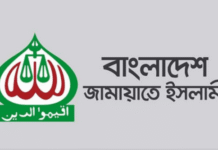Bangladesh: The Myth of Economic Growth

A construction site of the Dhaka Metro Rail Project near Rokeya Sharani. The project has been causing serious dust pollution in Dhaka. PHOTO: PALASH KHAN
by R. Chowdhury 29 July 2019
The government of Bangladesh under Prime Minister Sheikh Hasina Wazed keeps rattling the growth at 8-9% over the past few years, but the statistics do not tally with the global benchmarks, which find the actual number lower by up to 2 points. The lower figure may still look impressive, but the existence of glaring discrepancies in the development calculations rarely meets the eye, much less the outside observers. High stake corruptions in the administration and in Sheikh Hasina’s Awami League flatten whatever little progress the country makes, mostly through its private sector initiatives.
The Bangladesh Bureau of Statistics (BBS), a government agency, produces the inflated rates as per directives of the political leadership. If the BBS officials fail to comply, they are at risk of losing their jobs or facing other punitive consequences.
Where is the Remaining 2%?
Why these drummed up numbers? Because the rulers want to fake a “role model of progress” for Bangladesh, irrespective of the ground reality. In other words, it is their campaign to shield their many illegal acts and political wrongdoings. In their greed of staying in power, no concession is allowed in this ugly crusade. It is like charging a 98% scoring son about why he missed the 2 points. Given the sorry state of the opposition, thanks to the fascist practices imposed on the men and women on the other side of the fence, many observers believed that the ruling coalition would have won the December 2018 election comfortably. But the regime, which illegally held on to power through a managed election on December 29, 2008, and a farcical drama on January 5, 2014, was not willing to grant any concession to the opposition this time also. With the help of loyal administration, the police and party thugs, they made all possible illegal moves to keep the opposition candidates, activists, and voters away from the election. Yet, a “midnight coup” (stuffing ballot boxes of its own candidates in the dark the previous night) had to be staged to ensure an almost 100% victory. And yet, the infuriated ruling ruffians gang-raped women in front of their family members for voting for the non-Awami candidates. That is the role model of progress in Sheikh Hasina’s rule!
The economic numbers, whatever they are, mean little to the lower strata of society, which continue to groan under the heavy hands of authoritarian misrule. Former US President John F Kennedy said, “Economic growth without social progress lets the great majority of the people remain in poverty, while a privileged few reap the benefits of rising abundance.” That is exactly what is happening in Bangladesh today.
Amidst the administration’s drumming of high development, few outsiders notice the yawning gap between the rich few and the poor multitude in Bangladesh. It is like not seeing the wood for the trees.
Failing to Meet the Aspiration of Millions?
Failing to Meet the Aspiration of Millions?
A former Planning Minister of Bangladesh puts it nicely when he questioned: “At this point in time in Bangladesh, when democracy is brutally crucified, opposition successfully persecuted and crushed, good governance purposefully abandoned, corruption flying rampant, the rule of law gleefully eliminated,” how this predicament relates to the drummed-up excessive growth rater? The minister did not talk in the vacuum. To support his assertions, he cited extensive references from government figures and reports from various international sources including Amnesty International, Human Rights Watch, the Economist, the Washington Post, the New York Times, as well as the reports of The World Bank, The Asian Development Bank, and The International Monetary Fund.
He also does not agree with the slogan of development before democracy. “Sorry, this is not acceptable in a civilized world,” he says, further asserting, “Democracy and development go hand in hand.”
After touching an elephant, various blind men describe the mammoth animal differently, from pillar to a wall to a giant leech to a large flapping fan. Similarly, the citizens of Bangladesh see the “progress” differently. To a beneficiary of ill-gotten money–through corrupt practices– the growth is phenomenal. A poor person in the street and in the rural villages has not known it. To an opposition member, it is a torture cell. To the women who refused to obey the ruling thugs, it is hell!
After touching an elephant, various blind men describe the mammoth animal differently, from pillar to a wall to a giant leech to a large flapping fan. Similarly, the citizens of Bangladesh see the “progress” differently. To a beneficiary of ill-gotten money–through corrupt practices– the growth is phenomenal. A poor person in the street and in the rural villages has not known it. To an opposition member, it is a torture cell. To the women who refused to obey the ruling thugs, it is hell!
The government obviously crows the voice of the “filthy rich,” who are mostly aligned with the governing coterie. The rest, who form 90% of the population, do not figure in its consideration. People in this vast majority live on less than $2 a day, and over 30% of them are below the poverty level. There are three million unemployed and frustrated youths. Many poor rice farmers are forced to burn the results of their year-long toil for not getting what they invested. Hundreds of thousands attempt to escape the gloomy lives at home and venture out searching for a better future abroad, only to end up in various concentration camps if not already dead in the high seas.
“Averages are no consolation to those who have been left behind,” says Angus Deaton in his article, The Great Escape: Health, Wealth, and the Origins of Inequality. So, what good is that so-called development which does not match with the aspirations of the millions?
The bigger question is: Where is democracy, freedom, human rights, the rule of law, and harmonious development in this official bragging of “high development?”
People are tired of hearing the government’s slogan of “Development First, Democracy Later,” perhaps borrowing the theme from Pakistani President Ayub Khan’s “Decade of Development” campaign in the late 1960s. It did not work for Ayub Khan. Will it for Sheikh Hasina, the Prime Minister of Bangladesh? Only time will tell.
High Stake Corruption Drains the Progress
Moreover, whatever development the country achieves is drained by limitless, high stake corruption, mostly in collusion with top levels of leadership.
A little peek at the real picture: The Daily Star, a government affiliated paper, reported recently that bank loan defaults stand at more than $12 billion, much beyond the limit of the size of the national economy. Yet, another $2 billion of taxpayers money was infused to keep these failed banks afloat. Needless to say, these financial institutions belong to most of the 300 bank defaulters made public recently. But, “Mr. Justice” cannot touch them because they roam the corridors of power that be!
Bangladesh Bank, the central bank of the country, lost about $1 billion in an inside electronic scandal a few years back, and the stolen money, though traced, is all but lost to the public exchequer. In addition to the bank officials, people close to the top political leadership were suspected of having been involved in this heist.
Another fairy tale episode reported in 2018 in the Bangladesh Bank. Lied the touch of a magic wand, a large deposit of gold reserve turned to copper! Black magic, indeed!
The infamous Stock Market scams siphoned off billions of dollars from small-time investors, many of whom were totally ruined. The perpetrators of this con works were well known, yet they could not be touched because of their high political connections with the ruling authority. What is strange, the main character of the swindle advises the Prime Minister in her monetary investment policy, reminding us of the story of leasing the chicken to the jackal.
A little-known fact is that very high and disproportionate credit lines awarded to various projects landed Bangladesh with a public debt of $80 billion, registering a per capita debt increase by 250% in the past decade or so. Nigeria, Venezuela, and Sri Lanka are some of the once rich countries embarked on undertaking large prestige projects taking huge, high stake foreign loans, only to sink in debt and bankruptcy soon. More than a century ago, my grandfather acquired two wives and had 20 children. He could afford even more, given his financial standing and social status in his time. Today, most of his grandkids and great-grandkids are paupers, if not on the streets. Economists fear a similar future for Bangladesh.
Much of the showy projects like the Padma Bridge, Metrorail, Monorail, over-bridges, skyscrapers, underwater passageway, which, though necessary, are largely undertaken to benefit the government contractors and its brokers, who slice away a large chunk of the pie. These prestigious projects bring little benefit to 90% of the people who live far away from them.
The Prothom Alo, a Bengali daily, recently reported a piece of sensational news about the “Nuclear Pillow.” For the residents of a proposed nuclear power plant, ordinary sleeping pillows were procured each costing Taka 6800 ($85) a piece that included a carrying cost of Taka 800 from the ground to the room. The real cost would not have been more than $3 if similar pillows were bought locally. In the same vein, we can’t wait to see the cost of a nut for the Padma Bridge when completed. It may run well into hundreds of dollars. In Bangladesh, the making of one mile of road costs ten times higher than any other South Asian country, and five times more than in Europe. According to Singapore’s The Business Insider 2019, Bangladeshis have to cope with the highest cost of living with a lower per capita income in South Asia.
A Role Model Indeed!
“When government agencies can be bribed,” writes Sabria Chowdhury Balland in the South Asia Journal on April 16, 2019, “when there are no safety measures in construction, when roads are broken and congested with bumper to bumper traffic nearly all day, when unemployment soars with no vision of how to create jobs, when millions of youths do not have any guidance for their future, when the percentage of rapes skyrocket with no measures from lawmakers to hold the perpetrators accountable, etc. the big question remains: where is the progress?”
The pampered administration, which includes the police and military, are allowed lucrative massive perks for their “services” to the regime, such as conducting fraudulent elections and crushing any sign of dissent, to help it continue to stay in power.
Much of the ill-gotten money finds its way to personal accounts in offshore banks. Family members of the beneficiaries enjoy their lives in luxury in places like Canada, USA, Australia and Singapore and Malaysia whereas, the poor taxpayers routinely face batons and bullets, jails and torture, death and disappearance at home. A role model, indeed!
However, Bangladesh is a role model on many other counts. It is a role model where no opposition politics is allowed. It is a role model in which a three- time prime minister is left to die in a solitary cell after being clamped with a 17-year jail term on a nondescript, non-existent false case. It is a role model where the administration that includes the law enforcement agencies function as organs of the ruling party. It is a model where the Election Commission Anti-Corruption Commission and even the Judiciary follow the dictates of the political leadership. Or else…! Chief Justice S.K. Sinha is a case in point.
Ayub Khan, Saddam Hussain, Moammar Gaddafi, and many other dictators could not save themselves by the slogans of development before democracy. Can Hasina? We can wait for her fatal fall from the dangerously galloping tiger she is riding!









